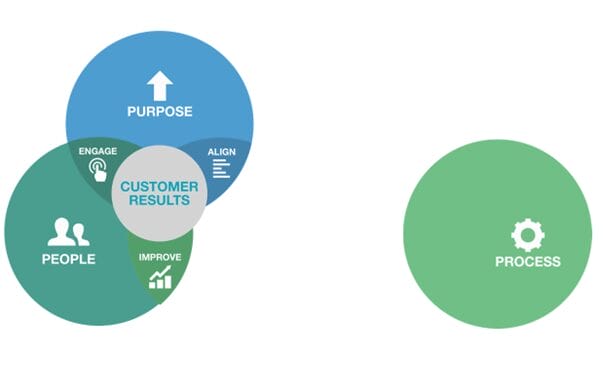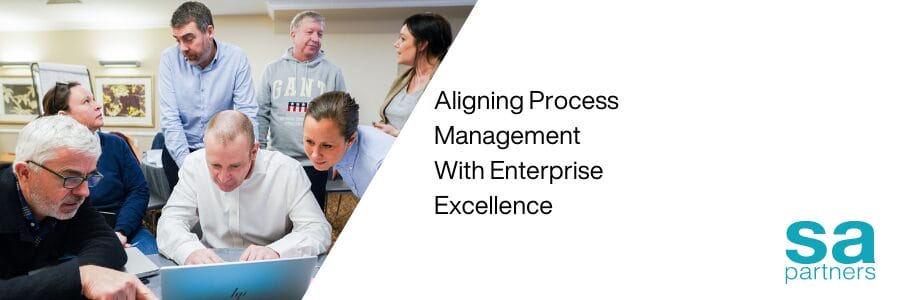I’m guessing that, given you’ve taken the time out of your day to read a blog on process management, you understand the importance of having clear and current documented processes. What we all need to remember though is that while process documentation is a necessity, it will do nothing on its own. This is why so many process management initiatives fizzle out – organisations create hundreds of process maps, but having these process maps in isolation doesn’t tangibly benefit the business, so the business loses interest, stops mapping and updating the maps, and the initiative is over.
Whenever I kick-off a new project, one of the first questions that I ask my client is What does Enterprise Excellence/ Operational Excellence mean to you? And the answers that I get are generally revolve around:
- Having a process driven culture
- Having one way of working
- Ensuring that everyone knows how they should be doing their job
To me this is the problem. Too often we confuse Enterprise Excellence with Process Management. The reality is that Process Management is a part of Enterprise Excellence, they’re not the same. With that in mind, we need to remind ourselves that our focus needs to be on achieving (or moving towards) Enterprise Excellence and therefore, our process management activities need to be performed in support of this cause.
This of course raises the question, what is Enterprise Excellence?

This is SA Partner’s Enterprise Excellence model and is made up of three core components, Purpose, Process, and People all in support of delivering Customer Results.
Purpose: This is why your organisation exists and the strategy that you have developed to achieve your purpose.
Process: This is the work that you do. It should be standardised and visible so that at any given point in time everyone should know exactly what they should be doing and how they should be doing it.
People: You need to ensure that you have the right people in place with the capability, capacity, and mindset to perform our processes.
When we happy map, what happens is that the Process component becomes disconnected from Enterprise Excellence. This causes us to end up with process documentation and assign process management work in isolation which fails to deliver customer results.

As a result, what we need to do is ensure that our process management activities are tightly aligned to our Enterprise Excellence efforts. To do this, what we’ve found is that the connectors between Purpose, Process, and People are of vital importance.
Align
Once we’ve determined our purpose and developed a strategy to achieve our purpose, we now need to ensure that our processes are aligned. This helps ensure that everyone is working on the right things and solves the problem of being busy, but rather than doing ‘busy work’ that doesn’t move the needle. As such, as part of our process management activities, we need to question if our as-is processes are aligned with our strategy and contribute to us achieving our purpose and, where they don’t, decide if the process needs to be changed or eliminated. Additionally, while our purpose will typically stay the same over time, our strategy will evolve. As our strategy evolves our process management activities needs to involve reviewing our existing processes and determining how they need to change in-order to remain aligned to our revised strategy. Once we’ve determined our purpose and developed a strategy to achieve our purpose, we now need to ensure that our processes are aligned. This helps ensure that everyone is working on the right things and solves the problem of being busy, but rather than doing ‘busy work’ that doesn’t move the needle. As such, as part of our process management activities, we need to question if our as-is processes are aligned with our strategy and contribute to us achieving our purpose and, where they don’t, decide if the process needs to be changed or eliminated. Additionally, while our purpose will typically stay the same over time, our strategy will evolve. As our strategy evolves our process management activities needs to involve reviewing our existing processes and determining how they need to change in-order to remain aligned to our revised strategy.
Improve
We need to start by capturing our As-Is processes. Not everyone will like it, but it has to be done. As-Is process capture is however just the starting point. Once we’ve captured our As-Is processes we need to look at them and question if they are fit for purpose? Particularly if you are starting with a culture that doesn’t appreciate process many of these processes won’t be followed so you need to invest energy in standardising them to make sure that the lived process aligns with the documented process. Also, these as-is processes will likely have waste, so you should also be thinking about how you can make them more efficient. Finally, as the environment in which these processes evolve, so too must your processes, so you need to ensure that your processes are continuously improved.
None of this improvement work will just happen though. As the model indicates, improvement isn’t just related to Process but also People. Your people need to have the capability (e.g. Problem Solving and Lean Improvement skills) to participate in process improvement as well as have time allocated away from working in the business to working on the business.
Engage
Having a purpose and strategy defined and understood by your Executive team is important, but for it to mean anything it needs to be understood and believed by your entire workforce. Part of your strategy should be Enterprise Excellence, the idea that the way that you work matters, not just the work that you do. And this needs to be communicated, understood, and believed by everyone in your organisation. They need to understand why we are doing this and be willing participants.
To summerise then, if you want your process management activities to deliver customer results, you can’t just be a happy mapper and create process documentation. You need to ensure that your process management activities are part of an Enterprise Excellence strategy which is done by aligning your processes with your purpose, building an improvement framework and creating capability and capacity in your people, and finally engaging your people with the role that Enterprise Excellence has in achieving your purpose.
Please contact me on moc.srentrapasobfsctd-5dbd9e@awehalles.nahsi with any questions.

